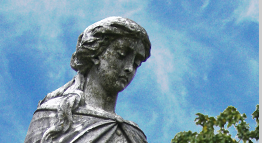



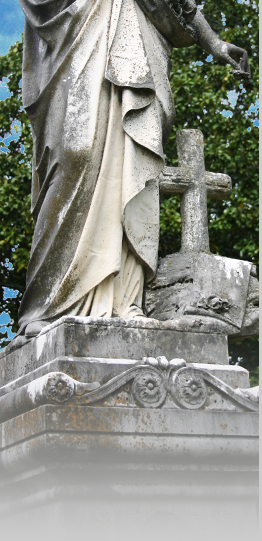
CONFEDERATE BURIAL GROUND
Greenwood is the final resting place of over twelve hundred Confederate soldiers with three hundred buried in private lots and the remainder in the Confederate Burial Ground, where soldiers who died in action during the Civil War in and around Jackson, or of disease in area hospitals were interred. Many were hastily buried in shallow graves by their fellow soldiers where they fell on the battlefield with eventual interment in the burial ground. Wooden headboards identified many names of the soldiers, some reportedly buried in mass graves.
The Daily Clarion, Jackson, Mississippi, April 27, 1867 reported citizens met at the cemetery to decorate the graves as "tokens of respect and affection…on every mound that indicated where a soldier slept". A list of names of the burials was published with the article arranged by states that had been tediously prepared by the Clarion from the headboards, some of which were so illegibly marked as to make it difficult to decipher the inscriptions. In view of frequent inquiries "by parties throughout the South as to the graves of their friends, and are often unable to show or describe the exact spot to them", the Ladies Cemetery Association was encouraged by the Clarion to adopt a plan for preservation of the graves, beginning with new and plainly marked headboards. The Greenwood Cemetery Association currently receives similar inquiries regarding grave locations.
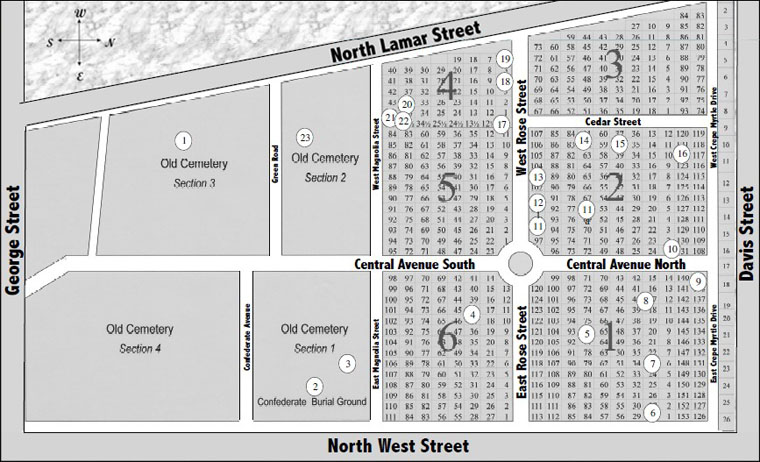
A Walking Tour of the Graves of Confederate Soldiers Buried in Greenwood Cemetery
The individual graves may be located by associating the numbers preceding the names of each person on this side with that on the map on the reverse side. The lot locations specified at the end of each narrative will also assist in locating the map numbers more easily.
| 1. Colonel Seaborne Moses Phillips |
Mustered into service March 2, 1861 Yazoo City, MS, as Captain of Yazoo Minute Rifles, Co. K 10th MS Regiment. Service as Lieutenant in Mexican War revealed heroic qualities useful as a commander; elected Colonel April 11, 1861 of 10th MS at Pensacola, FL, dying May 23, 1861 of pneumonia. A delegation of his troops accompanied his remains to Jackson for burial. Old Cemetery Section 3. |
|
 |
2. Brigadier General Samuel Wragg Ferguson |
Aidede- camp to General Beauregard March 1861. Promoted to Lt. Colonel 28th MS Cavalry Regiment 1862 in command of cavalry and outlying pickets at Vicksburg. As Brigadier General in 1863 actively harassed Sherman's movements during Georgia campaign, entering Savannah with his men to cover rear of Hardee's army during evacuation. Old Cemetery Section 1 Confederate Burial Ground. |
 |
3. Brigadier General James Argyle Smith |
Lieutenant US 6th Infantry in frontier campaigns 1853-1861. Resigned from US Army on May 9, 1861 to join Confederate Army, serving with same patriotic ardor and heroism as shown in his service under flag of the Union. His courage and tactical skills as commander in Battles of Shiloh, Perryville, Murfreesboro, Chickamauga, and Missionary Ridge lead to promotion as Brigadier General. Old Cemetery Section 1. |
 |
4. Lieutenant Colonel Jones Stewart Hamilton |
Appointed Adjutant General of MS and elected as state senator 1863. Lt. Colonel of Power's Brigade, MS Cavalry on return to war 1864. Secretary of MS Peace Commission which met in 1865 with President Andrew Johnson in Washington, and served as war claims agent for MS in 1866. He was indicted in 1887 for murdering a crusading newspaper editor during a gun fight on the old Town Creek bridge in Jackson but was later acquitted by a jury. Section 6 Lot 38. |
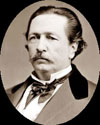 |
5. Colonel Charles Edward Hooker |
Lieutenant, Co. A, 1st MS Light Artillery; became Captain at Battle of Champion Hill. During assault on Vicksburg received severe wound, resulting in loss of his left arm. Promoted to Colonel of Cavalry; assigned duty on military court attached to command of Lt. General Polk. Appointed as lawyer from MS to defend Jefferson Davis in his treason trial in Richmond, VA. The case never came to trial. Prominent in rebuilding of state following the war. Section 1 Lots 77/78. |
 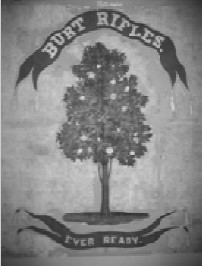 |
6. Colonel Erasmus R. Burt |
Recognized as being the father of the MS School for the Deaf. Organized a company designated as Burt's Rifles, later assigned as Co. A, 18th MS Inf Regiment. Burt elected as colonel of the regiment. 18th suffered heavy casualties at First Manassas (Bull Run) before being sent to Leesburg, VA. October, 1861 Union forces occupied Ball's Bluff. On the 21st the 18th led by Colonel Burt charged a Union artillery position. During the charge he was wounded in several places with one ball severing his spinal cord. He was carried to a home in Leesburg and finally died five days later. Lay in state in the Capitol rotunda before burial. First MS line officer killed in action. Section 1 Lot 28. |
 |
7. Major Henry W. Bridges |
Having been outflanked by enemy brigade Battle of Champion Hill, Brig. Gen. Wirt Adam's Cavalry fell back across Baker's Creek under orders of General Stephen D. Lee, sending Major Bridges with two escort companies to hold the flank movement in check, action in which Bridges fell mortally wounded. Believed dead on the battlefield, but found alive, was carried to Adj. Gen. Wharton's home in Jackson, where he lived for nine more days. Buried in Wharton's plot in the cemetery. Section 1, Lot 23. |
 |
8. Brigadier General Richard Griffith |
Regimental Adjutant 1st MS Rifles in Mexican War; following Colosecession appointed Adjutant General; elected Colonel of 12th MS Regiment; and commissioned Brigadier General November 12, 1861 of First Corps. Mortally wounded Battle of Savage Station near Richmond, VA, June 29, 1862. Following his funeral in Confederate White House in Richmond, President Davis arranged for his body to be taken to Jackson, MS for burial in Greenwood Cemetery. Section 1 Lot 17. |
 |
9. Adjutant William French |
10th MS Regiment; served with distinction throughout the war, including Battles of Shiloh, Murfreesboro, Chickamauga, Missionary Ridge, Atlanta, and Franklin . Taken prisoner at Ft. Craig as a result of remaining with his mortally wounded commanding officer, Col. Robert Smith, until his death. Enemy later allowed him to return to his unit under safe conduct. Section 1 Lots 138/139. |
 |
10. Colonel Robert A. Smith |
Captain, Co. A 10th MS Regiment; elected Colonel 10th MS May 1861. Mortal spinal wound September 15, 1862 Battle of Munfordville, KY; taken from battlefield by Sgt. Major William French and his brother -in-law Captain George Dobson, dying two days later. Early 1863 his sister, Herriot Dudley of Jackson, MS, and her son traveled by wagon to KY battlefield to recover his body for reburial in Greenwood Cemetery. General Bragg reported, "…the Colonel fell in gallant discharge of an almost desperate assault; esteemed and honored for his acquirements and heroic deportment. To me his loss was severe." Section 2 Lot 131. |
| 11. A & B William Henry Layton and Alexander Sparks | A & B William Henry Layton, Pvt 24th MS Infantry, and Alexander Sparks, Pvt. Fenner's LA Artillery, are the only known soldiers killed in the Battle of Jackson on June 12, 1863 to be buried in private lots in Greenwood Cemetery and not in the Confederate Burial Ground. Layton's first grave was plundered by Union soldiers. Layton, Section 2 Lot 99. Sparks, Section 2 Lot 68. | |
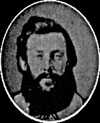 |
12. Colonel James Barr |
Marble cutter and sculptor of monuments, one of which is Rev. Amos Cleaver monument in circle on cemetery main road. Captain of 10th MS Regiment, promoted to Lt. Colonel December 1862 following Battle of Munfordville, KY, and to Colonel May 1863. Died Floyd House Hospital, Macon, GA June 25, 1864 of severe arm wound at Battle of Kolb’s Farm. Section 2 Lot 100. |
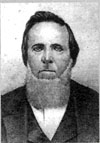 |
13. Dr. Samuel A. Cartwright |
Prior to the Civil War was an internationally acclaimed expert on Cholera and Yellow Fever. Jefferson Davis sent one of his young female slaves to New Orleans to be treated by Dr. Cartwright. During the war he was commissioned to prevent the spread in army posts in Mississippi. However, he himself fell victim to the disease as had so many other soldiers. Section 2 Lot 103. |
 |
14. Chaplain Thomas Withers Caskey | Appointed Chaplain of 18th MS Regiment, joining the young men of his congregation, the Christian Church, Jackson, MS in the war. Reportedly brandished a double cylinder sixteen-shooter revolver and a Colt rifle during his military service. Grave inscription reads "The Fighting Parson". Section 2 Lot 61. |
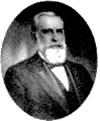 |
15. Colonel William Dunbar Holder |
Colonel of 17th MS Infantry, who suffered serious thigh and abdomen wounds, respectively at Battle of Malvern Hill and Battle of Gettysburg, permanently disabling him. Served in Confederate Congress for remainder of war. The W. D. Holder Chapter of United Daughters of the Confederacy in Jackson named in his honor. Section 2 Lot 38. |
 |
16. 1st Sergeant John Charles Rietti |
MS Rifles Company, Co A 10th MS Regiment 1861; Co D 1862. Present at surrender of Joseph E. Johnston’s Army, Greensboro, NC April 26, 1865. Kept detailed record of marches, battles and skirmishes of 10th MS. Following war was engaged in printing business. Compiled valuable regimental data in his Military Annals of Mississippi. Section 2 Lot 122. |
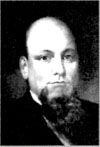 |
17. William Linn Hemingway |
Joined the Carroll County Rifles the same day it was formed and elected 3rd Lieutenant. During fighting at Gaines Mill, Virginia, when he raised his sword , a ball hit him in his armpit, passed under his shoulder blade, and lodged against his first rib. Following the Battle of Sharpsburg on September 17, 1862 he was deemed unfit for combat and discharged. Later in life after serving as State Treasurer he was convicted of embezzling state funds. His nephew proved that he was innocent and the governor pardoned him. Section 4 Lot 1½. |
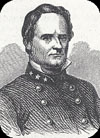 |
18. Brigadier General William Barksdale | Colonel, 13th MS Regiment, commanding Battles of First Manassas (Bull Run), Edwards Ferry, Richmond, and Savage Station, there taking command of brigade after Brig. Gen. Griffith was killed. Promoted Brigadier General August 1862. Mortally wounded July 2, 1863 Gettysburg battlefield with left knee wound, then hit by a cannon ball that nearly took his foot off, and finally hit in left chest, knocking him off his horse. Died during the night. Buried in unmarked grave near the Barksdale lot. Section 4 Lot 4. |
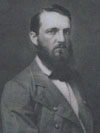 |
19. Colonel William Lewis Nugent |
Appointed MS Inspector General for defense preparations July 1861. Resigned to enter ranks, serving as Private, Co D 18th MS Cavalry; Captain, Adjutant General’s Department; and Colonel, 12th MS Cavalry 1865. His published Civil War letters considered an exceptional collection, revealing his candid observations of military strategy, commanders, soldier morale, camp life, and life on the home front. Section 4 Lot 6. |
| 20. Colonel Robert Young Brown |
Son of MS Governor Albert Gallatin Brown; served as Captain Co H 18th MS Regiment and was captured Battle of Gettysburg July 2, 1863. Released in prisoner exchange March 10, 1864. Appointed Major 6th MS Cavalry June 1, 1864 and Colonel 1865. Attorney in New Orleans, LA following the war until his death at age of 25 in 1866. Section 4 Lot 35. |
|
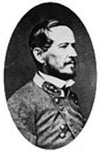 |
21. Brigadier General Daniel Weisiger Adams |
Appointed by governor to military board organizing the state for war. Appointed Lt. Colonel, 1st LA Regiment; promoted Colonel October 1861; and assumed brigade command Battle of Shiloh, where he lost his right eye at Hornet's Nest. Promoted to Brigadier General May 1862, leading his brigade in Battles of Perryville, Murfreesboro, Chickamauga, suffering two left arm wounds and was captured. Returned to duty early 1863 to lead his brigade at siege of Jackson, MS. Buried in unmarked grave reportedly next to his brother, William Wirt Adams. Section 4 Lot 44 |
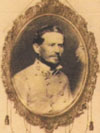 |
22. Brigadier General William Wirt Adams |
Appointed agent in LA to help that state secede. Formed Wirt Adams 1st MS Cavalry Regiment August 1861 as Colonel, leading fight of rear guard action as Confederates fled KY; guarded plantations and observed troop movements Vicksburg, MS. Commissioned Brigadier General September 1863. Surviving the war, Adams was killed in a gunfight with a newspaper editor with differing political views on the streets of Jackson, MS. Words were exchanged, both drew pistols, and in less than a minute both lay dead. Section 4 Lot 44. |
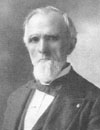 |
23. Colonel John Logan Power |
Newspaperman of Jackson, MS, chosen as official reporter of 1861 MS Secession Convention, publishing its proceedings. Adjutant, Withers’ 1st MS Light Artillery before appointed Supt. of Army Records for MS with rank of Colonel in 1864, taking him to Richmond, VA during closing years of Confederacy. On his return was secretary of Constitutional Convention of 1865. Instrumental in preservation of official state records of MS Confederate soldiers and historical data of some 600 regiments, companies, battalions, and brigades from MS, presently in collection of MS Dept. of Archives and History. Old Cemetery Section 2. |